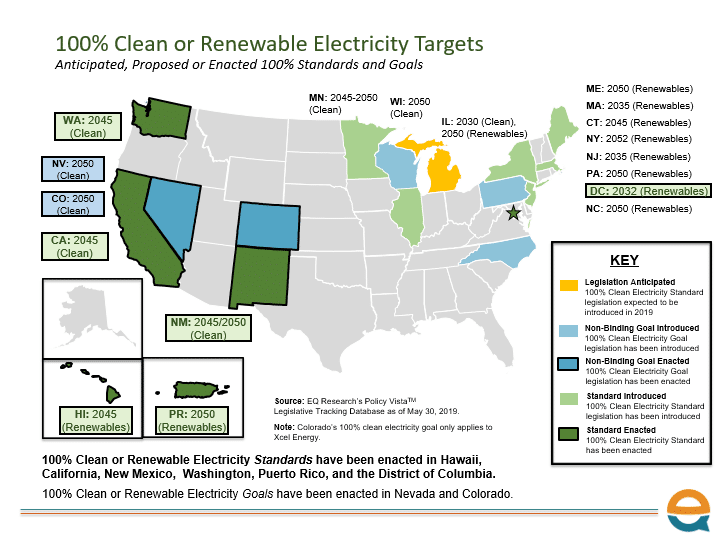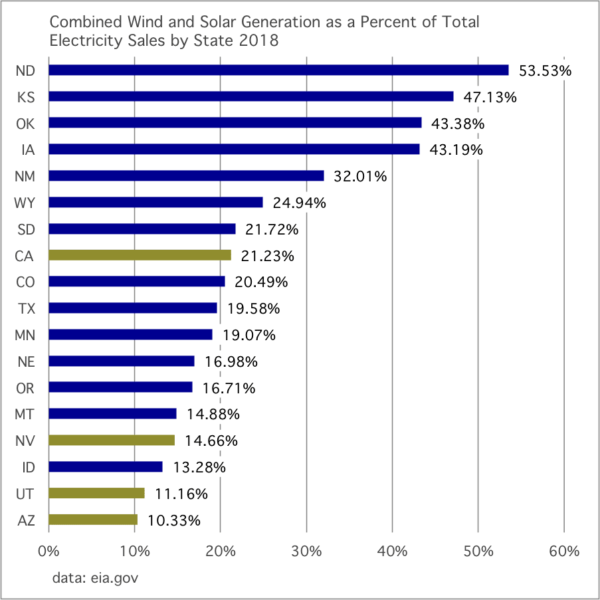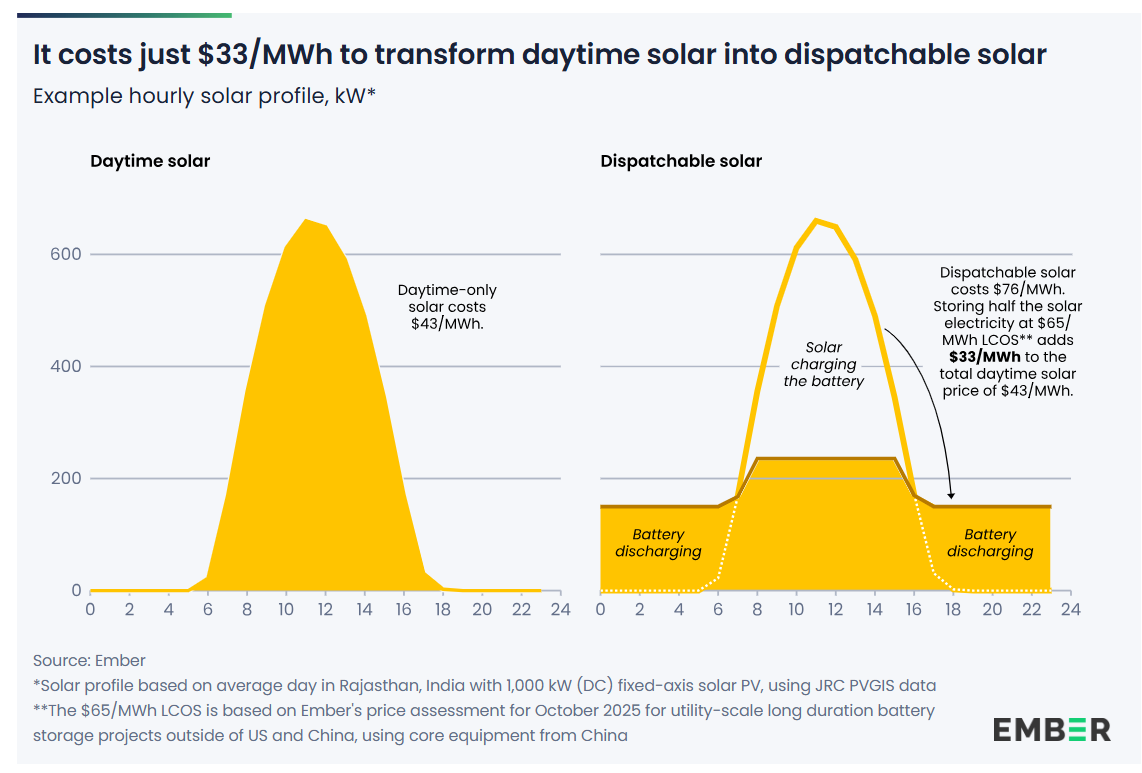The 100% clean energy movement has swept the United States. Over the last six months, dozens of cities including Chicago (population 2.7 million+) have joined New Mexico, Washington State, Puerto Rico and Washington D.C. in passing mandates that set a timeline by 2050 or sooner for utilities to entirely phase out fossil fuels in their electricity supply.
This brings us to the point where one in five Americans live in a jurisdiction that has passed such a policy. And with five more states considering legislation to do so, advocates say that this is just the beginning.

Or is it? Because there is one key caveat to this progress. As both we and Dave Roberts from Vox have pointed out, these 100% clean and/or renewable mandates have only been passed when the Republican Party controls neither house of the state legislature, nor the governor’s office.
If you needed further evidence of this, there is Minnesota’s omnibus energy act, which Governor Tim Walz (D) recently signed. This had started in the House with a 100% clean energy standard that was gutted in the Republican-majority Senate.
Even the few Republican politicians who claim to be concerned about climate change, such as Maryland Governor Larry Hogan (R), are balking at passing stronger clean and/or renewable energy mandates. Hogan recently let a 50% by 2030 renewable energy mandate pass without his signature, probably because the Democratic majorities in both Houses had the votes to over-ride a veto.
Red state renewable energy policies
But what one solar company representative in North Carolina described as “Acela corridor journalists” often overlook a critical distinction. Republican majorities have amply demonstrated that they won’t pass these mandates, but that doesn’t mean that they won’t pass policies that are favorable to renewable energy.
The recent example here is South Carolina, where the solar industry managed to get an overhaul of the state’s electricity policy, including eliminating caps on net metering, reforms of the utility planning process, allowing regulators to require all-source solicitations, and driving implementation of PURPA projects sitting in queues.
This was a major win for solar in a state government dominated by the Republican Party. Representatives of Solar Energy Industries Association (SEIA) and other trade groups have been clear that it was achieved by using messaging that focused on competition and markets, not concerns about climate change or any of the talking points that drive blue-state clean energy mandates.
In policy terms, opening the market to competition is a much weaker move than mandating renewables. But is this a paper victory, or will it drive mass adoption of solar?
Lessons from the wind industry
To answer that, it may help to look at the history of wind deployment. The United States got around 3x as much electricity from wind as it did from solar last year, and while renewable portfolio standard (RPS) policies definitely drove wind deployment, the states with the highest portions of wind are all red (Republican-dominated) states with no such mandates.
 That’s right: It is the Plains States that are leading the Energy Transition in the United States, not California – although it is not doing badly either.
That’s right: It is the Plains States that are leading the Energy Transition in the United States, not California – although it is not doing badly either.
So if it was not mandates that drove all this wind, what was it? There are three things to look at. The first is the Production Tax Credit (PTC), which has been repeatedly passed and repealed at the federal level, a pattern from which you can neatly track year-to-year wind deployment.
The second is that Texas – which has the largest volume of wind deployed of any state – socialized the cost of transmission to carry wind from its renewable energy zones in West and North Texas to population centers in the central and eastern parts of the state.
The geography factor
And then there is geography. Texas and the Plains States have enormous areas of awesome wind resources, and you can’t say this for the rest of the United States.
Incidentally, this is not only true for wind – the states with the strongest solar potential (California and the desert Southwest) host the bulk of the utility-scale solar deployed to date, although rooftop solar does not neatly follow this pattern.
And here lies the question: will wind and solar be deployed rapidly in areas where there is not such impressive resources, without mandates driving deployment? And some will ask: Should they?
If you are concerned about climate change, the answer is yes to the latter question, as deploying renewable energy has been one of the only success stories in reducing emissions. If you are not, then probably not. And given the stark partisan divide regarding concern about climate change in the United States, it follows that the leaders of red states would prefer to let the market decide whether or not, and how quickly, to decarbonize.
Ideology vs. reality
There is another wrinkle to this argument between free-market renewables and mandates. While market-based talking points are appealing to Republicans, the actions of Republican politicians do not consistently follow such principles.
Wind is, again, a perfect example. The PTC – a per-megawatt-hour subsidy for wind generation – is exactly the sort of thing that Republican politicians like to rail against. Yet it has survived in large part due to the protection of Senator Chuck Grassley (R-Iowa), who chairs the powerful Senate Finance Committee, and has been consistently backed by other Plains States Republicans eager to protect local industry and jobs.
The same can also be said of Texas’ socialized transmission lines. And this does not even get into the actions of Republicans in Ohio who are attempting to bail out coal and nuclear plants. Then there is the Trump Administration, which has openly attempted to rig wholesale power markets in favor of a coal industry that it has colluded with, and has imposed market-distorting tariffs as a foreign policy tool.
Mandate where you can
In the end, mandates have worked consistently and predictably to decarbonize electricity, and aggressive clean and/or renewable energy mandates have also been an important tool to provide stable markets. These policies are especially critical for states that don’t have overwhelming great resources.
Given the falling cost of solar and batteries, a level playing field in electricity works increasingly in favor of the Energy Transition. However the devil is always in the details and subsidies for conventional generation are often both concealed and hard to remove, which is why simple tools like net metering and clean energy mandates help to cut through the noise and get the job done.
Where Republicans hold power, opening the market is probably the best that we as an industry can do. And who knows? As shown by the wind industry, it just might work. Together, a combination of markets and mandates is what has driven the Energy Transition to date, and can continue to do so.
Editor’s note: Thanks to Gregor Macdonald and Ben Inskeep/EQ Research for providing excellent graphics to illustrate these points
The views and opinions expressed in this article are the author’s own, and do not necessarily reflect those held by pv magazine.
This content is protected by copyright and may not be reused. If you want to cooperate with us and would like to reuse some of our content, please contact: editors@pv-magazine.com.








Great article, thank you!
This lays out a solid roadmap for how to have discussions with people of multiple viewpoints–thank you for such a well-balanced piece.
Thanks!
What Molly said.
I came to the same conclusion as Molly. Well written article.
Thank you!